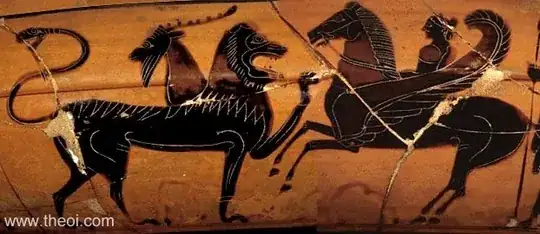I wasn't sure whether to ask this in history as it relates to art history, but the Chimera's appearance varies considerably in art throughout history. Designs vary in the proportion of lion, goat and snake. Some designs include a dragon. At least one design I recall seeing on a Greek or Roman plate has the lion front half transition into a giant snake past the chest. I am trying to find the earliest sources of these appearances as far as archaeology has been able to tell us.
1 Answers
Theoi to save the day!
The two earliest Greek works both attest to its general composition:
Homer, Iliad 6. 179 ff (trans. Lattimore) (Greek epic C8th B.C.) : "First he [King Iobates of Lykia (Lycia)] sent him [Bellerophon] away with orders to kill the Khimaira (Chimera) none might approach; a thing of immortal make, not human, lion-fronted and snake behind, a goat in the middle, and snorting out the breath of the terrible flame of bright fire. He killed the Khimaira, obeying the portents of the immortals."
Hesiod, Theogony 319 ff (trans. Evelyn-White) (Greek epic C8th or C7th B.C.) : "She [Ekhidna (Echidna)] bore the Khimaira (Chimera), who snorted raging fire, a beast great and terrible, and strong and swift-footed. Her heads were three: one was that of a glare-eyed lion, one of a goat, and the third of a snake, a powerful drakon (serpentine-dragon). But Khimaira (Chimera) was killed by Pegasos (Pegasus) and gallant Bellerophon. But she also, in love with Orthos (Orthrus) [the two-headed dog], mothered the deadly Sphinx . . . and the Nemeian Lion."
As far as early depictions, there are several (still linked) 6th century depictions, and they're all pretty consistent.
- 7,713
- 1
- 31
- 61
